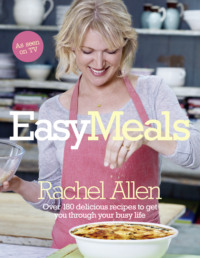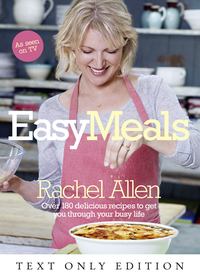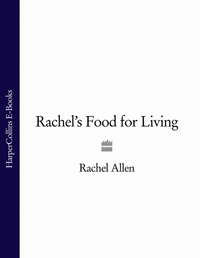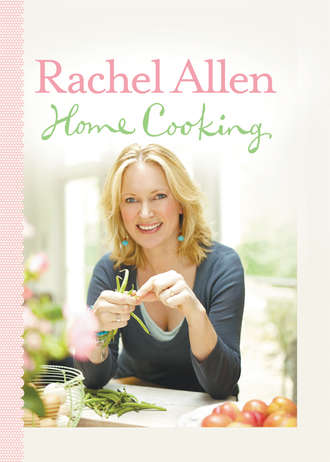
Полная версия
Home Cooking
7 Make a hole, about 5mm (¼in) wide in the centre of the pastry at the top of the pie and cook in the oven for approximately 1 hour and 10 minutes—1 hour and 20 minutes or until golden brown and a skewer inserted into the middle comes out hot (too hot to hold on the inside of your wrist). Allow to cool for at least 30 minutes before removing from the tin. When cooled, cut into slices to serve.
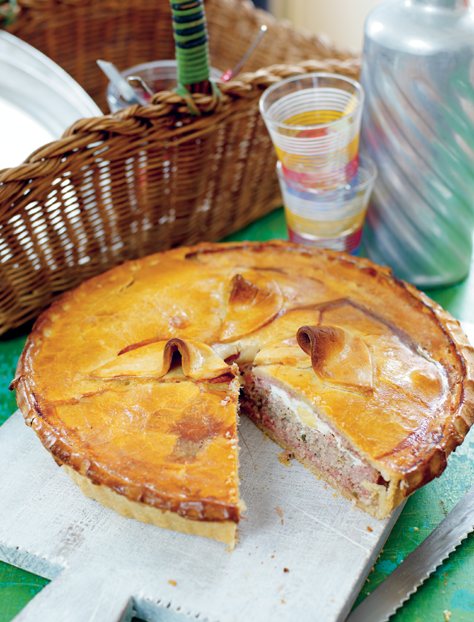

Linguini with shrimps, garlic and herbs
SERVES 4 – 6
A simple, classic Italian dish that is a particular favourite with my family. We try to get hold of shrimps (or small prawns) as often as possible. Use spaghetti if you don’t have linguini or why not try making your own pasta (see page 130)? 1 Fill a large saucepan with water, add 1 teaspoon of salt and bring to the boil. Add the linguini and cook for 10–12 minutes (or follow the instructions on the packet), stirring occasionally, until just tender.
Salt and freshly ground black pepper
300g (11oz) linguini
110g (4oz) butter
500g (18oz) cooked and peeled shrimps or small prawns
4 cloves of garlic, peeled and crushed
1 red chilli, deseeded and finely chopped (optional)
2 tbsp chopped mixed herbs, such as parsley, chives, dill, tarragon or chervil
Squeeze of lemon juice Lemon slices, to serve
2 Meanwhile, melt the butter in a frying pan on a medium heat and, once sizzling, add the shrimps (or prawns), garlic and chilli (if using) and season with salt and pepper. Cook for 4–5 minutes, tossing regularly until warmed through and becoming golden.
3 Drain the now cooked linguini (leaving a couple of tablespoons of the cooking liquid in the saucepan) and return it to the pan, removed from the heat. Stir in the herbs and tip the shrimp mixture onto the pasta.
4 Toss everything together and check the seasoning, adding enough lemon juice to taste and more salt and pepper if necessary. Serve immediately.
Rachel’s tip
For a quick and easy snack or a simple starter, simply cook and serve the shrimps or prawns with crusty bread instead of the linguini.
Tagliatelle with smoked salmon, watercress and peas
SERVES 4
This is a really good pasta dish, great for all the family, and it makes a little bit of smoked salmon go a long way. Use rocket instead of watercress if you can’t get hold of it. If you’d like to make your own pasta, try the recipe on page 130.
Salt and freshly ground black pepper
500g (1lb 2oz) tagliatelle
200g (7oz) crème fraîche
200g (7oz) smoked salmon, sliced into strips 1cm (Hin) wide
50g (2oz) frozen peas
25g (1oz) finely grated Parmesan cheese
Good squeeze of lemon juice
2 tbsp chopped chives
50g (2oz) watercress leaves, roughly chopped
1 Fill a large saucepan with water, add 1 teaspoon of salt and bring to the boil. Add the tagliatelle and cook for 10–12 minutes (or follow the instructions on the packet), stirring occasionally, until just tender.
2 In the meantime, place the crème fraîche in a saucepan on a low heat and gently warm through for 1 minute. Add the smoked salmon strips and cook for 2–3 minutes, stirring occasionally.
3 Meanwhile, cook the peas in a small saucepan of boiling, salted water (I usually take some of the pasta cooking water from the large saucepan) for 1–2 minutes or until just cooked. Add the peas to the crème fraîche mixture along with three-quarters of the Parmesan cheese, the lemon juice and half of the chives, and stir together. Season to taste with salt and pepper and remove from the heat.
4 Drain the cooked pasta (leaving a couple of tablespoons of the cooking liquid in the saucepan) and return it to the saucepan, removed from the heat. Scatter with the watercress and pour over the crème fraîche mixture. Toss everything together so that all the ingredients are well combined and check the seasoning, adding more salt and pepper or lemon juice if necessary. Divide between plates or pasta bowls, scatter with the remaining chives and serve.
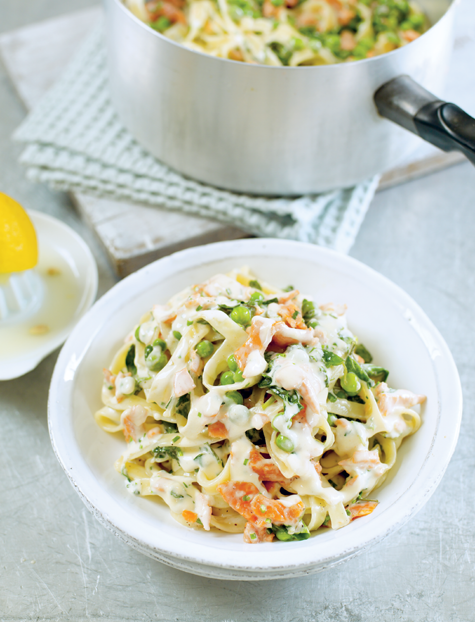
Fish cakes
SERVES 4
Fish cakes are a great way of using up leftover cooked potato and fish and they go down well with children. You can also experiment with other ingredients like chilli, finely chopped cooked vegetables or different herbs to give a different flavour each time. Serve the fish cakes with a flavoured mayonnaise (see overleaf) or tomato relish.
600g (1lb 5oz) floury potatoes
Salt and freshly ground black pepper
400g (14oz) skinned white fish, such as cod, haddock or hake
150g (5oz) butter, diced
4 tbsp white wine
Juice of ¼ lemon
150g (5oz) button mushrooms, sliced
200g (7oz) cooked and peeled shrimps or small prawns, any larger ones chopped
2 egg yolks
3 tsp Dijon mustard
4 tbsp finely chopped herbs, such as parsley, tarragon, dill or chives (either one herb or a mixture)
3–4 tbsp olive oil
To serve
Salad leaves
Lemon wedges
1 Cook the potatoes as described in the mash recipe (see page 116). Peel and mash (but without adding any butter or milk) and transfer to a large bowl.
2 Meanwhile, place the fish in a wide, shallow saucepan and add 100g (3½oz) of the butter, the wine and the lemon juice. Season with salt and pepper, then cover with a lid and gently poach on a low heat for 10–15 minutes or until the fish is cooked through. Carefully remove the fish from the pan and set aside to cool a little. Turn up the heat to high and boil the poaching liquid until it has reduced by half.
3 In the meantime, melt 25g (1oz) of the butter in a small frying pan and sauté the mushrooms on a medium heat for 8–10 minutes or until soft and golden, seasoning with salt and pepper. Set aside and allow to cool a little.
4 Add the fish, reduced poaching liquid and cooked mushrooms to the mash along with the shrimps or prawns, egg yolks, mustard and herbs. Gently mix everything together, breaking the fish up as you go but being careful not to mash it up too much. Season to taste with salt and pepper.
5 Shape the mixture into eight patties (each about 8cm/3in wide and 2cm/¾in thick) and arrange on a baking sheet or large plate. Cover with cling film and place in the fridge for about 1 hour to firm up. (The fish cakes can be prepared to this stage in advance and either frozen or kept in the fridge for up to 24 hours.)
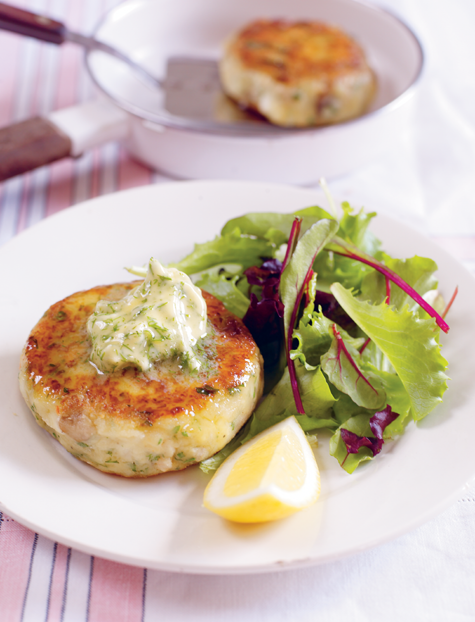
6 Place the olive oil and remaining butter in a large, non-stick frying pan on a low—medium heat and very gently fry the fish cakes for about 5 minutes on each side or until golden and warmed through, adding a little more oil or butter to the pan during cooking if necessary.
7 Divide the fish cakes between plates, add some salad leaves to each plate and serve immediately with your choice of accompaniment from below.
Accompaniments
Flavoured mayonnaise: Serve with the tomato aioli or herb and garlic mayonnaise (see pages 175 and 330) or simply add the finely grated zest of 1 lemon to the homemade mayonnaise (see page 330).
Herb butter: Serve with the dill butter (see page 327) or make a different flavoured butter by stirring 1 heaped tablespoon of your favourite herb, chopped, into 75g (3oz) softened butter until it is well blended.
Poached salmon with hollandaise
SERVES 4
When wild salmon is in season it’s one of the best fish to serve — quite unbeatable, and this is such an easy recipe. When poaching salmon, or indeed any fish, be sure to use as little water as necessary to minimise flavour loss. Use a saucepan that will just fit the fish. Also, I like to only add salt to the cooking water and no other flavourings. Add 1 tablespoon of salt to every 1.2 litres (2 pints) water. Salmon is delicious served with asparagus and steamed or boiled new potatoes.
Salt
18–20cm (7–8in) piece of salmon, still on the bone, cut from a whole fish that has been gutted and descaled (ask your fishmonger to do this if necessary)
300ml (½ pint) hollandaise sauce (see page 331)
1 Bring a saucepan of salted water to the boil (see above for pan size and quantity of salt to add). Slide in the salmon, bring back up to the boil and then reduce the heat, cover with a lid and gently simmer for 20 minutes. Remove from the heat and leave the salmon to stand in the cooking liquid for 5 minutes, which will continue cooking the fish.
2 Carefully remove the salmon from the water, and when cool enough to handle, remove the skin and any brown sediment by scraping gently with a small, sharp knife. You will see that there are four segments of salmon on the bone. Run the knife carefully down the seam of each segment to release the portions away from the bone, giving four portions in total.
3 Serve immediately with the hollandaise sauce.
Rachel’s tip
If you are feeding lots of people, poach a whole salmon in a fish kettle. If you only want to poach one section of the salmon, you can freeze the rest for another time.
I van Allen’s dressed crab with tomato and basil salad
SERVES 6
Ivan Allen was Isaac’s grandfather and this is his recipe. I remember him coming into the kitchens at Ballymaloe and checking the dressed crab to ensure it was just right. Try to find whole crabs so that that you can use both the white and flavourful brown meat. I’ve given instructions for cooking a crab from scratch, but if you can’t get hold of a whole crab, you can use ready-cooked frozen crab meat instead. Try serving with a good-quality tomato relish.
How to cook a crab
1 First place the crab in the freezer for a couple of hours so that it is unconscious before boiling. To cook a crab, place it in a large saucepan, cover with warm water, add 1 tablespoon of salt for every 1.2 litres (2 pints) of water and bring to the boil. Simmer on a medium heat for 20 minutes per 450g (1lb) and then pour off about two-thirds of the water, cover with a lid and continue to cook for a further 6 minutes. To check to see if the crab is cooked, gently shake it quite close to your ear and you shouldn’t hear liquid splashing around. Remove the crab and allow to cool.
2 First remove the large claws and crack these (using a heavy weight or nut crackers), then extract every bit of meat using the handle of a teaspoon. Retain the shell if making dressed crab (see overleaf), otherwise discard. Turn the body of the crab upside down and pull out the centre portion. Discard the gills, known as ‘dead man’s fingers', each about 4cm (1½in) long. Scoop out all the lovely brown meat and add it to the white meat from the claws. The meat can be used immediately or frozen for future use.
Rachel’s tip
450g (1lb) of cooked crab in the shell yields approximately 175–225g (6–8oz) crab meat.
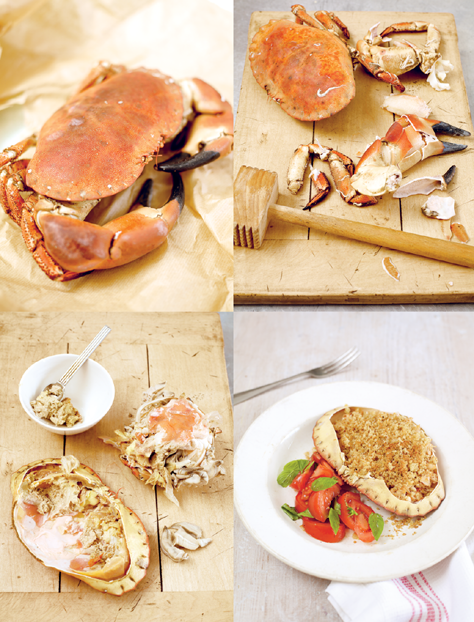
425g (15oz) brown and white meat from 2–3 cooked fresh crabs, reserving the crab shells
100g (3½oz) soft white breadcrumbs
150ml (5fl oz) white sauce (see page 327)
2 tbsp tomato chutney or tomato relish
2 tsp white wine vinegar
1 tsp Dijon mustard or a generous pinch of dry mustard powder
75g (3oz) butter, melted
Salt and freshly ground black pepper
100g (3½oz) white breadcrumbs
For the tomato and basil salad
8 vine-ripened tomatoes (using one variety or a mixture)
Pinch of caster sugar
Good squeeze of lemon juice
2–3 tbsp extra-virgin olive oil
Small handful of basil leaves, larger leaves torn
Two or three crab shells or six 250ml (9fl oz) ramekins or small dishes
How to dress a crab
1 Preheat the oven to 180°C (350°F), Gas mark 4. If using the crab shells, scrub them clean, dry well and arrange upside down on a baking tray. Alternatively, place the ramekins or small dishes on the tray.
2 In a large bowl, mix together the crab meat, breadcrumbs, white sauce, chutney or relish, vinegar, mustard and 25g (1oz) of the melted butter and season to taste with salt and pepper. Spoon the mixture into the crab shells or ramekins. In a separate bowl, toss together the breadcrumbs with the remaining butter and sprinkle over the crab mixture.
3 Bake in the oven for 15–20 minutes until heated through and browned on top. Briefly place under a preheated grill, if necessary, to crisp up the crumbs.
4 In the meantime, prepare the salad. Cut the tomatoes into quarters or 1cm (½in) slices. Spread out in a single layer on a large flat plate and season to taste with salt, pepper and sugar. Add the lemon juice, drizzle over the olive oil and scatter with the basil leaves and toss gently together.
Конец ознакомительного фрагмента.
Текст предоставлен ООО «ЛитРес».
Прочитайте эту книгу целиком, купив полную легальную версию на ЛитРес.
Безопасно оплатить книгу можно банковской картой Visa, MasterCard, Maestro, со счета мобильного телефона, с платежного терминала, в салоне МТС или Связной, через PayPal, WebMoney, Яндекс.Деньги, QIWI Кошелек, бонусными картами или другим удобным Вам способом.





